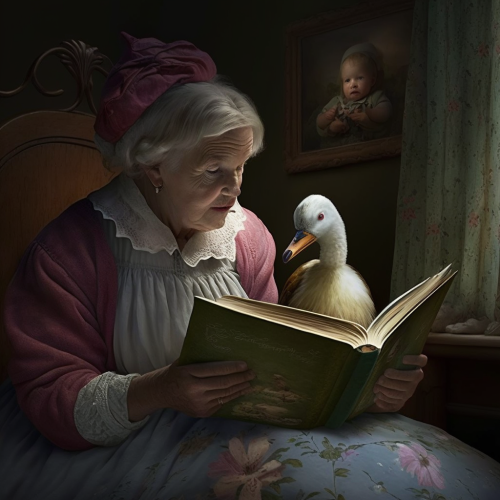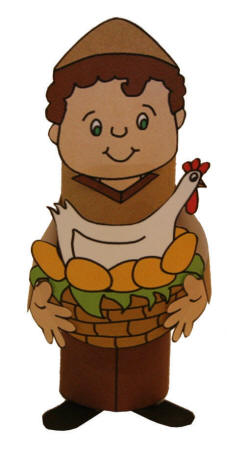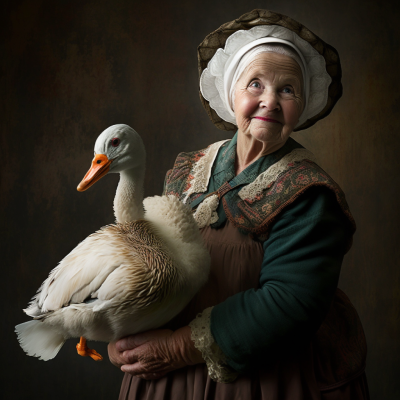DLTK's Educational Activities
Celebrate Mother Goose Day, May 1st
 Mother Goose Day is an annual event, celebrated on May 1st, that pays tribute to the timeless nursery rhymes and enchanting Fairy Tales that have been an integral part of childhood for countless generations. On this special day, children and adults alike come together to honor the whimsical world of Mother Goose and the imaginative stories that have captured our hearts and minds.
Mother Goose Day is an annual event, celebrated on May 1st, that pays tribute to the timeless nursery rhymes and enchanting Fairy Tales that have been an integral part of childhood for countless generations. On this special day, children and adults alike come together to honor the whimsical world of Mother Goose and the imaginative stories that have captured our hearts and minds.
About Mother Goose:
Mother Goose is a mythical figure often portrayed as an elderly woman who shares captivating stories with children. While the origins of this character remain uncertain, Mother Goose has become synonymous with the enchanting realm of nursery rhymes and Fairy Tales. Since the 17th century, she has been a beloved figure in children's literature, with her stories passed down from one generation to the next.
 Five Most Popular Mother Goose Fairy Tales
Five Most Popular Mother Goose Fairy Tales
- Cinderella - The origins of the Cinderella story can be traced back to ancient times, with various cultures having their own versions. The oldest known version is from China, dating back to the 9th century. However, the version most familiar to modern audiences is based on Charles Perrault's 1697 French rendition, "Cendrillon," which introduced elements such as the fairy godmother, pumpkin carriage, and glass slippers. The Brothers Grimm also recorded a variant called "Aschenputtel" in their collection of German folktales.
- Jack and the Beanstalk - The origins of "Jack and the Beanstalk" can be traced back to English and Celtic folklore, with the story possibly having ancient roots. Several variations of the tale exist, but the version most familiar to modern audiences is based on "The Story of Jack Spriggins and the Enchanted Bean," published in 1734. The tale evolved over time, and the story we know today, with the beanstalk and the giant's castle, was popularized in the 19th century.
- Sleeping Beauty - The story of Sleeping Beauty has roots in various European folktales. The earliest known version is the Italian tale "Sun, Moon, and Talia" by Giambattista Basile, published in 1634. Charles Perrault's "La Belle au bois dormant" (1697) added several elements to the story, including the wicked fairy and the sleeping curse. The Brothers Grimm included a version called "Little Briar Rose" in their collection, drawing from earlier Germanic sources.
- Little Red Ridinghood - The origins of Little Red Riding Hood can be traced back to European oral traditions. The story was passed down through generations and took on various forms. Charles Perrault's 1697 version, "Le Petit Chaperon Rouge," introduced the red hood as an identifying feature of the main character. The Brothers Grimm later recorded a different version, "Rotkäppchen," which added the rescue by a huntsman and the moral lesson about being cautious with strangers.
- Goldilocks and the Three Bears - The origins of "Goldilocks and the Three Bears" are uncertain, but the story is thought to have originated from British oral traditions. The earliest printed version appeared in 1837, written by Eleanor Mure, featuring an old woman instead of a young girl. The character of Goldilocks was introduced later, in 1849, by author and poet Robert Southey, who based his version on an earlier oral rendition. The story has since become a classic, teaching children about respecting others' property and the consequences of curiosity.
Five Most Popular Mother Goose Nursery Rhymes
 Humpty Dumpty - The origins of "Humpty Dumpty" are uncertain, but it is believed to date back to the 18th century. One popular theory suggests that the rhyme refers to a large cannon used during the English Civil War that fell off a wall and broke, rendering it useless. However, the rhyme itself does not explicitly mention Humpty Dumpty as an egg, which is a later addition popularized by illustrations accompanying the rhyme in children's books.
Humpty Dumpty - The origins of "Humpty Dumpty" are uncertain, but it is believed to date back to the 18th century. One popular theory suggests that the rhyme refers to a large cannon used during the English Civil War that fell off a wall and broke, rendering it useless. However, the rhyme itself does not explicitly mention Humpty Dumpty as an egg, which is a later addition popularized by illustrations accompanying the rhyme in children's books. - Mary Had a Little Lamb - This nursery rhyme was written by Sarah Josepha Hale in 1830 and is based on a real-life incident. Mary Sawyer, a young girl from Massachusetts, had a pet lamb that she brought to school one day, which led to the creation of this iconic rhyme. The story became popular, and the rhyme is still enjoyed by children today.
- Twinkle, Twinkle Little Star - The lyrics for this nursery rhyme were written by Jane Taylor in 1806 and were originally published as a poem called "The Star." The poem was later set to the tune of a French melody called "Ah! vous dirai-je, Maman," which dates back to the 18th century. The song has become one of the most recognizable lullabies worldwide.
- Little Bo Peep - The exact origins of "Little Bo Peep" are unclear, but it is believed to have been first published in the early 19th century. The rhyme may have its roots in the tradition of shepherding, and it tells the story of a young shepherdess who loses her sheep. The moral of the story is to be patient and trust that things will work out in the end.
- Jack and Jill - "Jack and Jill" is an English nursery rhyme that dates back to the 18th century. The exact origins are unknown, but there are several theories about its meaning. Some suggest that the rhyme has connections to the French Revolution, while others argue that it might be related to the story of King Charles I and his attempts to reform the tax on liquid measures, which eventually led to a decrease in the volume of a "Jack" and a "Gill" (two old English units of measurement). However, these interpretations are speculative, and the rhyme's true meaning remains uncertain.
 Fun Facts about Nursery Rhymes:
Fun Facts about Nursery Rhymes:
- Nursery rhymes have been around for centuries and were initially used to convey political and social commentary in a humorous manner.
- Many nursery rhymes are based on true events or historical figures, such as "Mary, Mary Quite Contrary," which is believed to be about Mary, Queen of Scots.
- Some nursery rhymes, like "Ring Around the Rosie," have dark origins and are thought to be about the bubonic plague.
- Nursery rhymes are valuable tools for early childhood education, as they can help children develop language, literacy, and cognitive skills.
Mother Goose Day is a time to celebrate the joy, wonder, and magic of childhood through the captivating stories that have captured our imaginations for generations. Whether you're reciting nursery rhymes with your children, engaging in creative crafts, or simply enjoying a good book, Mother Goose Day offers the perfect opportunity to celebrate the enchanting world of storytelling and the cherished memories it creates.
More Nursery Rhymes and Fairy Tales >